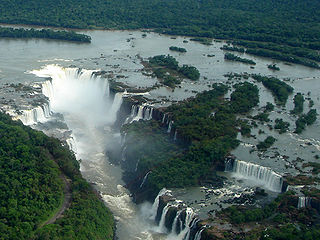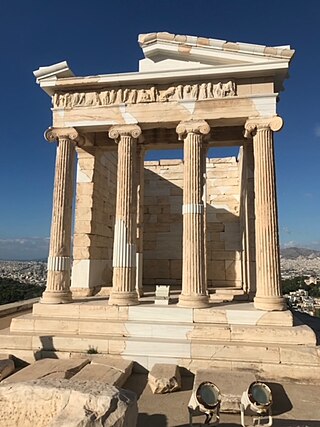


Archaeotourism or Archaeological tourism is a form of cultural tourism, which aims to promote public interest in archaeology while conserving historical sites.



Archaeotourism or Archaeological tourism is a form of cultural tourism, which aims to promote public interest in archaeology while conserving historical sites.
Archaeological tourism can include all products associated with public archaeological promotion such as: visits to archaeological sites, museums, interpretation centers, reenactments of historical occurrences, and the rediscovery of indigenous products, festivals, or theaters.[ citation needed ]
Archaeological tourism promotes archaeological sites and an area's cultural heritage. Its intent is to not cause more damage to the sites, thus avoiding becoming invasive tourism. [2] Archaeologists have expressed concerns that tourism encourages particular ways of seeing and knowing the past. [3] When archaeological sites are run by tourist boards, ticket fees and souvenir revenues can become a priority. The tradeoff between opening a site to the public or remaining closed and keeping the site out of harm's way should be assessed. [4] Damage to irreplaceable archaeological materials is not only direct, as when remains are disordered, altered, destroyed, or looted, but often an indirect result of poorly planned development of tourism amenities, such as hotels, restaurants, roads, and shops. These can alter the environment producing flooding, landslides, or undermining ancient structures. [5]

World Heritage Sites are landmarks and areas with legal protection by an international convention administered by UNESCO for having cultural, historical, or scientific significance. The sites are judged to contain "cultural and natural heritage around the world considered to be of outstanding value to humanity".
In the broadest sense, cultural resource management (CRM) is the vocation and practice of managing heritage assets, and other cultural resources such as contemporary art. It incorporates Cultural Heritage Management which is concerned with traditional and historic culture. It also delves into the material culture of archaeology. Cultural resource management encompasses current culture, including progressive and innovative culture, such as urban culture, rather than simply preserving and presenting traditional forms of culture.

Cultural tourism is a type of tourism in which the visitor's essential motivation is to learn, discover, experience and consume the cultural attractions and products offered by a tourist destination. These attractions and products relate to the intellectual, spiritual, and emotional features of a society that encompasses arts and architecture, historical and cultural heritage, culinary heritage, literature, music, creative industries as well as the living cultures with their lifestyles, value systems, beliefs and traditions.

Cultural heritage tourism is a form of non-business travel whereby tourists engage with the heritage, tangible and intangible, moveable and immovable, of a region through activities, experiences, and purchases which facilitate a connection to the people, objects, and places of the past associated with the locations being visited. As opposed to natural heritage tourism, which focuses on visitors' interaction with the unimproved environment of the area being visited, including outdoor sports and recreation, hiking, diving, fishing, and naturalism, and pleasure tourism without any heritage interest, such as indoor recreation, gastronomy, and hospitality without any significant precedent in the history and heritage of the region, cultural heritage tourism can include activities such as tours of immovable cultural sites, such as historic house museums, historic fortifications, human history museums, and library documentary heritage collections, opportunities for purchases of moveable cultural property, such as antiques, antiquarian books, and other works and ephemera associated with the locations being visited, and opportunities for admission to or purchase of intangible heritage experiences associated with the tourism region, including gastronomic heritage and admissions to performances such as theatre, opera, ballet, indigenous dances, and storytelling.

Yankari Game Reserve is a large wildlife park and former National Park located in the south-central part of Bauchi State, in northeastern Nigeria. It covers an area of about 2,244 km2 (866 sq mi) and is home to several natural warm water springs, as well as a wide variety of flora and fauna. Its location in the heartland of the West African savanna makes it a unique way for tourists to watch wildlife in its natural habitat. Yankari was created as a game reserve in 1956, but later designated Nigeria's biggest national park in 1991. It is the most popular destination for tourists in Nigeria and plays a crucial role in the development and promotion of tourism and ecotourism in Nigeria. It is also a popular eco-destination in West Africa.
Archaeological ethics refers to the moral issues raised through the study of the material past. It is a branch of the philosophy of archaeology. This article will touch on human remains, the preservation and laws protecting remains and cultural items, issues around the globe, as well as preservation and ethnoarchaeology.

An ancient monument can refer to any early or historical manmade structure or architecture. Certain ancient monuments are of cultural importance for nations and become symbols of international recognition, including the ruins of Baalbek on Lebanese currency, the Angkor Wat on Cambodian currency and the Great Wall of China on the Chinese currency. There are some countries that display ancient buildings as symbols on their coats of arms as a way to affirm national identity. In this way, ancient monuments in the modern world are used as icons to represent a country. The importance of ancient monuments extends to cultural heritage and how the people of a nation or city identify themselves.

Cultural heritage is the heritage of tangible and intangible heritage assets of a group or society that is inherited from past generations. Not all heritages of past generations are "heritage"; rather, heritage is a product of selection by society.

Cultural heritage management (CHM) is the vocation and practice of managing cultural heritage. It is a branch of cultural resources management (CRM), although it also draws on the practices of cultural conservation, restoration, museology, archaeology, history and architecture. While the term cultural heritage is generally used in Europe, in the US the term cultural resources is in more general use specifically referring to cultural heritage resources.
The Valletta Treaty (formally the European Convention on the Protection of the Archaeological Heritage (Revised), also known as the Malta Convention) is a multilateral treaty of the Council of Europe. The 1992 treaty aims to protect the European archaeological heritage "as a source of European collective memory and as an instrument for historical and scientific study". All remains and objects and any other traces of humankind from past times are considered to be elements of the archaeological heritage. The archaeological heritage shall include structures, constructions, groups of buildings, developed sites, moveable objects, monuments of other kinds as well as their context, whether situated on land or under water." (Art. 1)

Sustainable tourism is a concept that covers the complete tourism experience, including concern for economic, social, and environmental issues as well as attention to improving tourists' experiences and addressing the needs of host communities. Sustainable tourism should embrace concerns for environmental protection, social equity, and the quality of life, cultural diversity, and a dynamic, viable economy delivering jobs and prosperity for all. It has its roots in sustainable development and there can be some confusion as to what "sustainable tourism" means. There is now broad consensus that tourism should be sustainable. In fact, all forms of tourism have the potential to be sustainable if planned, developed and managed properly. Tourist development organizations are promoting sustainable tourism practices in order to mitigate negative effects caused by the growing impact of tourism, for example its environmental impacts.
Kamoke is a city in the Gujranwala, Punjab, Pakistan. It ranks as the 30th largest city in Pakistan according to the 2017 census with a population of 249,767. Kamoke is known for its prominent rice market, being one of the largest in the sub-continent, and for its numerous mosques.

Geotourism is tourism associated with geological attractions and destinations. Geotourism deals with the abiotic natural and built environments. Geotourism was first defined in England by Thomas Alfred Hose in 1995.
The European Route of Industrial Heritage (ERIH) is a tourist route of the most important industrial heritage sites in Europe. This is a tourism industry information initiative to present a network of industrial heritage sites across Europe. The aim of the project is to create interest for the common European heritage of the Industrialisation and its legacy. ERIH also wants to promote regions, towns and sites showing the industrial history and market them as visitor attractions in the leisure and tourism industry.
Tourism in Ethiopia accounted for 5.5% of the country's gross domestic product (GDP) in 2006, having barely increased 2% over the previous year. The government is proving its commitment and willingness to develop tourism through a number of initiatives. Tourism is a featured component of Ethiopia's Poverty Reduction Strategy Paper (PRSP), which aims to combat poverty and encourage economic development.

The conservation and restoration of archaeological sites is the collaborative effort between archaeologists, conservators, and visitors to preserve an archaeological site, and if deemed appropriate, to restore it to its previous state. Considerations about aesthetic, historic, scientific, religious, symbolic, educational, economic, and ecological values all need to be assessed prior to deciding the methods of conservation or needs for restoration. The process of archaeology is essentially destructive, as excavation permanently changes the nature and context of the site and the associated information. Therefore, archaeologists and conservators have an ethical responsibility to care for and conserve the sites they put at risk.
Tourism impacts tourist destinations in both positive and negative ways, encompassing economic, political, socio-cultural, environmental, and psychological dimensions.

Cultural governance is governance of culture. It includes cultural policy made by governments but extends also to cultural influence exerted by non-state actors and to policies which influence culture indirectly.
Heritage management in the Philippines is guided by laws and agencies that create regulations for potentially destructive behaviors such as excavations and demolition. Legislation pertaining to heritage management consists of Republic Acts and Presidential Decrees. Organizations such as UNESCO, the National Commission for Culture and the Arts, and the Heritage Conservation Society are also referred to in laws.
Maryam Al Zadjali is an Omani painter, whose work is inspired by Omani traditions and Islamic artistic practices. In 2008 she was appointed Director of the Omani Society for Fine Arts (OSFA).